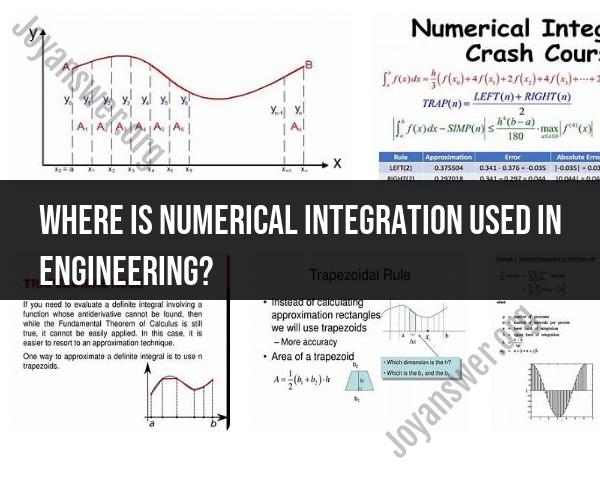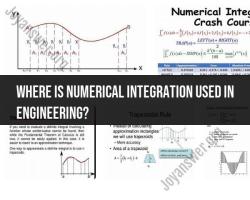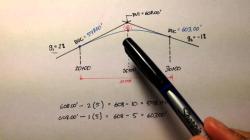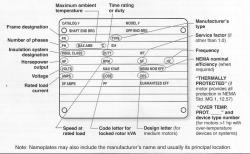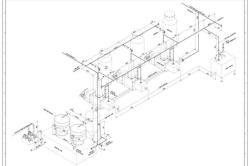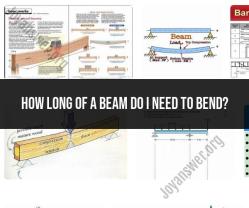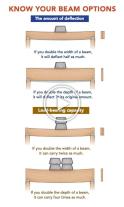Where is numerical integration used in engineering?
Numerical integration, also known as numerical methods for integration, is widely used in engineering for various practical applications where analytical solutions are challenging or impossible to obtain. Some key areas in engineering where numerical integration is applied include:
Simulation and Modeling:
- Numerical integration is fundamental in simulating and modeling physical systems. Engineers use it to solve differential equations that describe the behavior of dynamic systems such as circuits, control systems, and mechanical structures.
Finite Element Analysis (FEA):
- FEA is a powerful numerical technique used to analyze complex structures and systems. Numerical integration is employed to evaluate integrals arising from the discretization of equations governing the behavior of materials and structures.
Heat Transfer and Fluid Dynamics:
- In the analysis of heat transfer and fluid flow problems, numerical integration helps solve partial differential equations that describe the distribution of temperature, pressure, and velocity in different engineering systems like heat exchangers and fluid pipelines.
Control System Design:
- Engineers use numerical integration to model and analyze dynamic systems in control theory. It plays a crucial role in designing controllers for systems with complex dynamics.
Signal Processing:
- Numerical integration is used in signal processing applications, such as the analysis of signals in communication systems and the computation of discrete Fourier transforms.
Electric Circuit Analysis:
- In electrical engineering, numerical integration is applied to analyze and simulate electrical circuits. It helps calculate transient responses, analyze circuit behavior, and solve complex circuit equations.
Structural Analysis:
- Structural engineers use numerical integration to analyze the behavior of structures under different loads. This is crucial in determining factors like stress, strain, and deformation.
Optimization Problems:
- Numerical integration is employed in optimization algorithms to find the minimum or maximum of a function. This is useful in engineering design processes where engineers seek optimal solutions.
Robotics and Kinematics:
- In robotics, numerical integration is used to solve kinematic equations, enabling engineers to model the motion of robot arms and design control strategies.
Aerospace Engineering:
- Numerical integration is applied in the analysis of trajectories, aerodynamics, and propulsion systems in aerospace engineering. It helps predict the behavior of vehicles in flight.
Numerical integration provides engineers with a powerful set of tools to solve complex mathematical problems that arise in the analysis, design, and optimization of various engineering systems and processes. It allows for the efficient and accurate solution of problems that may not have closed-form solutions.
In which engineering applications is numerical integration commonly used?
Numerical integration is a powerful tool in various engineering disciplines, finding applications in a wide range of areas. Here are some common engineering applications where numerical integration plays a crucial role:
1. Structural Engineering:
- Calculating member forces and deflections: In analyzing structures like bridges, buildings, and machines, numerical integration is used to evaluate integrals arising from governing equations (e.g., moment-area method, stiffness method). This helps determine forces and deflections in structural members under various loading conditions.
- Analysis of plates and shells: For complex structures like shells and plates, analytical solutions aren't always feasible. Numerical integration allows engineers to approximate stresses and displacements in these structures, ensuring their safety and integrity.
2. Mechanical Engineering:
- Motion analysis: Calculating displacement, velocity, and acceleration of moving components in machines and mechanisms often involves integrating kinematic equations. Numerical integration provides accurate approximations even for complex motions.
- Heat transfer analysis: Determining heat flow and temperature distribution in systems like engines, heat exchangers, and electronic devices necessitates solving heat transfer equations using numerical integration techniques.
3. Aerospace Engineering:
- Orbital mechanics: Calculating satellite trajectories and spacecraft maneuvers relies heavily on numerical integration of differential equations governing their motion. This ensures accurate prediction and control of their path through space.
- Aerodynamics: Analyzing airflow around aircraft wings and structures involves integration of complex aerodynamic equations. Numerical methods help engineers optimize designs for lift, drag, and stability.
4. Chemical Engineering:
- Reactor design: Modeling chemical reactions within reactors often involves integrating rate equations that describe the conversion of reactants to products. Numerical integration allows engineers to optimize reactor design for efficient production and maximize yield.
- Mass and heat transfer: Analyzing mass and heat transfer processes in equipment like distillation columns and heat exchangers requires solving differential equations using numerical integration. This helps optimize processes and predict equipment performance.
5. Civil Engineering:
- Fluid flow analysis: Modeling water flow in rivers, dams, and hydraulic structures involves integrating differential equations describing fluid dynamics. Numerical methods provide accurate predictions of flood risks, sedimentation patterns, and optimal design of hydraulic structures.
- Geotechnical analysis: Analyzing stability of slopes, foundations, and soil structures often requires evaluating integrals of soil properties and stresses. Numerical integration allows engineers to assess potential risks and optimize designs for geotechnical stability.
This list is just a glimpse into the vast applications of numerical integration in engineering. It is a versatile tool that helps engineers solve complex problems, analyze systems, and optimize designs across various disciplines.
